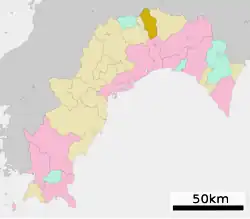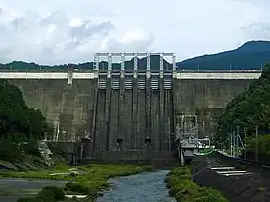Motoyama, Kōchi
Motoyama (本山町, Motoyama-chō) is a town located in Nagaoka District, Kōchi Prefecture, Japan. As of 31 July 2022, the town had an estimated population of 3‚318 in 1858 households and a population density of 25 persons per km².[1]The total area of the town is 134.22 square kilometres (51.82 sq mi). Motoyama has been named one of The Most Beautiful Villages in Japan. [2]
Motoyama
本山町 | |
|---|---|
 View of Motoyama on route 439 | |
 Flag  Chapter | |
Location of Motoyama in Kōchi Prefecture | |
 | |
 Motoyama Location in Japan | |
| Coordinates: 33°45′N 133°35′E | |
| Country | Japan |
| Region | Shikoku |
| Prefecture | Kōchi |
| District | Nagaoka |
| Area | |
| • Total | 134.22 km2 (51.82 sq mi) |
| Population (July 31, 2022) | |
| • Total | 3,318 |
| • Density | 25/km2 (64/sq mi) |
| Time zone | UTC+09:00 (JST) |
| City hall address | 504 Motoyama, Motoyama-chō, Nagaoka-gun, Kōchi-ken 781-3692 |
| Climate | Cfa |
| Website | Official website |
| Symbols | |
| Bird | Japanese robin |
| Flower | Cherry blossom |
| Tree | Hinoki |


.jpg.webp)
Geography
Motoyama is located in the Shikoku Mountains near the center of northern Kōchi Prefecture. The upper reaches of the Yoshino River and Shikoku's largest dam, the Sameura Dam are located in the town.
Climate
Motoyama has a humid subtropical climate (Köppen climate classification Cfa) with hot, humid summers and cool winters. There is significant precipitation throughout the year, especially during June and July. The average annual temperature in Motoyama is 14.2 °C (57.6 °F). The average annual rainfall is 2,892.3 mm (113.87 in) with September as the wettest month. The temperatures are highest on average in August, at around 25.2 °C (77.4 °F), and lowest in January, at around 3.3 °C (37.9 °F).[3] The highest temperature ever recorded in Motoyama was 38.1 °C (100.6 °F) on 28 July 2007; the coldest temperature ever recorded was −8.9 °C (16.0 °F) on 16 January 2011.[4]
| Climate data for Motoyama (1991−2020 normals, extremes 1977−present) | |||||||||||||
|---|---|---|---|---|---|---|---|---|---|---|---|---|---|
| Month | Jan | Feb | Mar | Apr | May | Jun | Jul | Aug | Sep | Oct | Nov | Dec | Year |
| Record high °C (°F) | 18.8 (65.8) |
23.6 (74.5) |
26.2 (79.2) |
31.5 (88.7) |
33.2 (91.8) |
35.2 (95.4) |
38.1 (100.6) |
37.7 (99.9) |
35.3 (95.5) |
30.9 (87.6) |
25.1 (77.2) |
22.6 (72.7) |
38.1 (100.6) |
| Average high °C (°F) | 9.3 (48.7) |
10.5 (50.9) |
14.3 (57.7) |
19.9 (67.8) |
24.4 (75.9) |
26.7 (80.1) |
30.6 (87.1) |
31.4 (88.5) |
27.8 (82.0) |
22.7 (72.9) |
16.7 (62.1) |
11.2 (52.2) |
20.5 (68.8) |
| Daily mean °C (°F) | 3.3 (37.9) |
4.2 (39.6) |
7.7 (45.9) |
12.7 (54.9) |
17.3 (63.1) |
21.0 (69.8) |
24.8 (76.6) |
25.2 (77.4) |
21.9 (71.4) |
16.2 (61.2) |
10.5 (50.9) |
5.3 (41.5) |
14.2 (57.5) |
| Average low °C (°F) | −1.1 (30.0) |
−0.5 (31.1) |
2.3 (36.1) |
6.7 (44.1) |
11.9 (53.4) |
17.1 (62.8) |
21.1 (70.0) |
21.6 (70.9) |
18.1 (64.6) |
12.0 (53.6) |
6.3 (43.3) |
1.2 (34.2) |
9.7 (49.5) |
| Record low °C (°F) | −8.9 (16.0) |
−8.4 (16.9) |
−5.7 (21.7) |
−2.7 (27.1) |
1.9 (35.4) |
7.2 (45.0) |
13.4 (56.1) |
14.0 (57.2) |
7.8 (46.0) |
2.3 (36.1) |
−2.8 (27.0) |
−5.6 (21.9) |
−8.9 (16.0) |
| Average precipitation mm (inches) | 67.6 (2.66) |
103.6 (4.08) |
173.6 (6.83) |
196.0 (7.72) |
241.9 (9.52) |
352.6 (13.88) |
452.6 (17.82) |
410.1 (16.15) |
426.9 (16.81) |
226.4 (8.91) |
122.3 (4.81) |
95.6 (3.76) |
2,892.3 (113.87) |
| Average precipitation days (≥ 1.0 mm) | 7.5 | 9.0 | 11.7 | 10.8 | 10.8 | 14.5 | 13.8 | 13.7 | 12.8 | 9.2 | 7.6 | 7.9 | 129.3 |
| Mean monthly sunshine hours | 149.0 | 145.3 | 165.4 | 184.2 | 188.7 | 122.6 | 145.7 | 160.6 | 125.4 | 146.5 | 133.1 | 135.3 | 1,801.8 |
| Source: Japan Meteorological Agency[4][3] | |||||||||||||
Population and Demographics
The population in Motoyama was 7,343 in 1965, but as of May 2017 it has gone down to 3‚605 and continues to decrease.[5]
According to the 2005 census: the population of people 15 years old and under is 417, the population of those 65 years and over is 1,657 and the percentage of seniors in Motoyama is 38% compared to the prefectural average of 26%. There are 1,835 households with on average 2.32 people per household. The number of people per household continues to decrease as households with seniors continue to increase. It is assumed that this trend will continue for the foreseen future.
| Year | Pop. | ±% |
|---|---|---|
| 1960 | 8,476 | — |
| 1965 | 7,343 | −13.4% |
| 1970 | 7,052 | −4.0% |
| 1975 | 6,265 | −11.2% |
| 1980 | 6,011 | −4.1% |
| 1985 | 5,566 | −7.4% |
| 1990 | 5,215 | −6.3% |
| 1995 | 4,901 | −6.0% |
| 2000 | 4,657 | −5.0% |
| 2005 | 4,374 | −6.1% |
| 2010 | 4,109 | −6.1% |
| 2015 | 3,573 | −13.0% |
| 2020 | 3,261 | −8.7% |
| Motoyama population statistics[6] | ||
History
As with all of Kōchi Prefecture, the area of Motoyama was part of ancient Tosa Province. During the Edo period, the area was part of the holdings of Tosa Domain ruled by the Yamauchi clan from their seat at Kōchi Castle. The village of Nishi-Motoyama was established with the creation of the modern municipalities system on October 1, 1889 out of 12 smaller hamlets. It was renamed Motoyama Village on June1, 1890. Motoyama was raised to town status on June 1, 1910. On April 20, 1955, Motomachi merged with the neighboring town of Yoshino. However, on April 1, 1961, five western hamlets of Motomachi were transferred to the neighboring town of Tosa.
Government
Motoyama has a mayor-council form of government with a directly elected mayor and a unicameral town council of ten members. Motoyama, together with the other municipalities of Tosa District and Nagaoka District, contributes one member to the Kōchi Prefectural Assembly. In terms of national politics, the village is part of Kōchi 1st district of the lower house of the Diet of Japan.
Economy
The economy of Motoyama is based forestry, agriculture and the raising of Japanese Brown beef cattle.
Education
Motomachi has two public elementary schools and one public middle school operated by the town government, and one public high school operated by the Kochi Prefectural Board of Education
Transportation
Railway
Motoyama has no passenger railway service. The nearest station is Ōsugi Station on the JR Shikoku Dosan Line; however, most passengers travel to Kōchi Station by bus.
Highways
Sister city relations
 - Upper Darby Township, Delaware County, Pennsylvania, United States, friendship city since August 10, 1966
- Upper Darby Township, Delaware County, Pennsylvania, United States, friendship city since August 10, 1966
Local attractions
Events
- Flower Festival (Hana-matsuri) March 25 – May 6
- A festival which welcomes the coming of spring along with the blooming of various flowers. Cherry blossoms and Tsutsuji (azalea) can be seen in the central area of Motoyama, while the highlight of the festival can be seen at the nearby Kizenzan Park (帰全山公園) where over 30,000 Shakunage (rhododendron) are displayed.
- Asemi River Marathon late July
- An annual marathon first held in 1986, where roughly 500 participants run along the Asemi river.
- Yoshino River Rafting Festival middle of August
- This raft racing festival has origins from when lumber traders shipped hinoki (cypress) wood from Shiraga Mountain in rafts down the river. Participants can race in either traditional style raft racing or the free style division. The traditional style race involves teams with 6 participants racing on rafts made of wooden logs over 5m in length. The free style class involves participating teams bringing their own self made rafts. These teams compete over not just the visual attractiveness of the raft but also the `style` in which they raft down the river.
- Town Festival middle of August
- The annual town festival features a traditional Taiko performance, Bon odori (Japanese folk dance), and fireworks. There is also a parade leading up to the festival where Yosakoi style dancing can be seen.
- Athletic Festival early October
- This 50-year-old festival features teams from various businesses and professions participating in athletic competitions. Hundreds of locals participate in various athletic games in hopes of promoting the benefits of team work and healthy competition.
- Autumn Culture Festival middle of November
- Held during the time of harvest in Motoyama. There are also shops set up from Motoyama's sister town, Urausu. The local community center hosts stage performances and also exhibits local art. At the closing of the festival, a Mochi scattering ceremony is held where hundreds of people fill the assembly grounds.
Tourist sites

- Mount Kizen Park (帰全山公園, Kizen-zan kõen)
- In spring time the park is full of cherry blossoms and shakunage flowers (rhododendron), a sight that is famous within Kochi prefecture. In fact, the park is also called Shakunage Park. At the entrance is a statue of Kenzan Nonaka (野中 兼山), a local politician during the Edo period.
- Mount Shiraga (白髪山, Shiraga-yama)
- At 1470 m Shiraga is Motoyama's most prominent mountain. When ascending the mountain, one can see hinoki (cypress) trees from 150 to 200 years old by the road side.
- There are two approach sites where mountaineers can begin their ascent, which should take no more than 90 minutes.
- Asemi River Glen (汗見川渓谷, Asemigawa keikoku)
- A location with thousands of years of history with beautiful flowers in the spring but is also a great place to go camping in the summer.
- Akadaki Falls (赤滝)
- Deep inside the mountains one can see a waterfall that sews its way through the greenery and foliage.
References
- "Motoyama town official statistics" (in Japanese). Japan.
- Nihon de mottomo utsukushii mura rengō
- 気象庁 / 平年値(年・月ごとの値). JMA. Retrieved April 19, 2022.
- 観測史上1~10位の値(年間を通じての値). JMA. Retrieved April 19, 2022.
- (All statistics are provided in the official town website )
- Motoyama population statistics
External links
- Official website (in Japanese)
- Motoyama Board of Education website